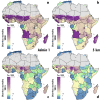Variation in Childhood Diarrheal Morbidity and Mortality in Africa, 2000-2015
- PMID: 30231224
- PMCID: PMC6078160
- DOI: 10.1056/NEJMoa1716766
Variation in Childhood Diarrheal Morbidity and Mortality in Africa, 2000-2015
Abstract
Background: Diarrheal diseases are the third leading cause of disease and death in children younger than 5 years of age in Africa and were responsible for an estimated 30 million cases of severe diarrhea (95% credible interval, 27 million to 33 million) and 330,000 deaths (95% credible interval, 270,000 to 380,000) in 2015. The development of targeted approaches to address this burden has been hampered by a paucity of comprehensive, fine-scale estimates of diarrhea-related disease and death among and within countries.
Methods: We produced annual estimates of the prevalence and incidence of diarrhea and diarrhea-related mortality with high geographic detail (5 km2) across Africa from 2000 through 2015. Estimates were created with the use of Bayesian geostatistical techniques and were calibrated to the results from the Global Burden of Diseases, Injuries, and Risk Factors Study 2016.
Results: The results revealed geographic inequality with regard to diarrhea risk in Africa. Of the estimated 330,000 childhood deaths that were attributable to diarrhea in 2015, more than 50% occurred in 55 of the 782 first-level administrative subdivisions (e.g., states). In 2015, mortality rates among first-level administrative subdivisions in Nigeria differed by up to a factor of 6. The case fatality rates were highly varied at the national level across Africa, with the highest values observed in Benin, Lesotho, Mali, Nigeria, and Sierra Leone.
Conclusions: Our findings showed concentrated areas of diarrheal disease and diarrhea-related death in countries that had a consistently high burden as well as in countries that had considerable national-level reductions in diarrhea burden. (Funded by the Bill and Melinda Gates Foundation.).
Figures





References
Publication types
MeSH terms
Grants and funding
LinkOut - more resources
Full Text Sources
Other Literature Sources
Medical
